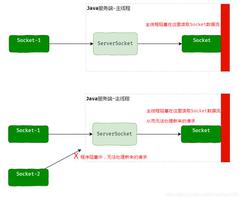201521123113 《Java程序设计》第4周学习总结

1.1 尝试使用思维导图总结有关继承的知识点。
1.2 使用常规方法总结其他上课内容。
- 设计类的技巧:类名和方法名要能够体现他们的职责,类名首字母要大写
- 如何识别一个类
- 方法、属性的注释用
/*
*
*
*/来注释
- 对象的设计
2.书面作业
Q1.注释的应用
使用类的注释与方法的注释为前面编写的类与方法进行注释,并在Eclipse中查看。(截图)Q2.面向对象设计(大作业1,非常重要)
2.1 将在网上商城购物或者在班级博客进行学习这一过程,描述成一个故事。(不得少于50字,参考QQ群中PPT的范例)
- 用户打开淘宝网页,根据淘宝页面的分类选择你想要的产品,每件产品都有他对应的价格、信息等属性;例如选择要买一套衣服,把要购买的衣服、裤子等添加进购物车,购物车能把每件商品的价格和总价格做一个统计,并结算总价,付款。
2.2 通过这个故事我们能发现谁在用这个系统,系统中包含的类及其属性方法,类与类之间的关系。尝试找到这些类与属性,并使用思- 维导图描述类、属性、方法及类与类之间的关系。
PS:百度脑图不能加箭头,购物车可以看成另一个类,继承了所有加入购物车的商品类。
Q3.ManagerTest.zip代码分析
分析ManagerTest.zip中的代码,回答几个问题:3.1在本例中哪里体现了使用继承实现代码复用?回答时要具体到哪个方法、哪个属性。
class Manager extends Employee{
/**
* @param n the employee's name
* @param s the salary
* @param year the hire year
* @param month the hire month
* @param day the hire day
*/
public Manager(String n, double s, int year, int month, int day)
{
super(n, s, year, month, day);
bonus = 0;
}
public double getSalary()
{
double baseSalary = super.getSalary();
return baseSalary + bonus;
}
public void setBonus(double b)
{
bonus = b;
}
private double bonus;
}
- Manager继承了Employee类的getSlaray()方法,name、salary、hireDay等属性。
3.2 Employee类及其子类Manager都有getSalary方法,那怎么区分这两个方法呢?
- 子类中:
public double getSalary() {
double baseSalary = super.getSalary();
return baseSalary + bonus;
}
- 在子类中用super关键字来调用父类的函数。
3.3 文件第26行e.getSalary(),到底是调用Manager类的getSalary方法还是Employee类的getSalary方法。
- 第一次调用的是Manager类的getSalary方法第二第三次是调用了Employee类的getSalary方法。
staff[0] = boss; staff[1] = new Employee("Harry Hacker", 50000, 1989, 10, 1);
staff[2] = new Employee("Tommy Tester", 40000, 1990, 3, 15);
// print out information about all Employee objects
for (Employee e : staff)
System.out.println("name=" + e.getName() + ",salary=" + e.getSalary());
}
}
- 由代码可以用看出,staff[0]的类为Manager,staff[1]、staff[2]都是Employee类。
也可从输出截图看出
3.4 Manager类的构造函数使用super调用父类的构造函数实现了代码复用,你觉得这样的有什么好处?为什么不把父类构造函数中的相关代码复制粘贴到Manager的构造函数中,这样看起来不是更直观吗?
- 遇到许多共有的属性方法时不用多次写类似的代码,节省时间和代码的简洁性和可靠性。
- 有些重复的代码不用重复写,最好只写一次,然后可以在其他地方直接引用,这样可以提高代码重用率,缩减代码量,同时也有助于提高代码的可读性和可维护性。
Q4.Object类
4.1 编写一个Fruit类及属性String name,如没有extends自任何类。使用System.out.println(new Fruit());是调用Fruit的什么方法呢?该方法的代码是从哪来的?尝试分析这些代码实现了什么功能?
class fruit{ private String name;
}
public class Fruit {
public static void main(String[] args) {
System.out.println(new Fruit());
}
}
输出 Fruit@368102c8
- 是调用了Fruit的toString()方法,因为所有类默认继承Object类。
public void println(Object x) { String s = String.valueOf(x);
synchronized (this) {
print(s);
newLine();
}
}
- 从println的源代码可以看出,object类的输出是一串字符串。
4.2 如果为Fruit类添加了toString()方法,那么使用System.out.println(new Fruit());调用了新增的toString方法。那么其父类中的toString方法的代码就没有了吗?如果同时想要复用其父类的toString方法,要怎么操作?(使用代码演示)
class Fruit{ private String name;
@Override
public String toString() {
return "Apple";
}
}
public class som {
public static void main(String[] args) {
System.out.println(new Fruit());
}
}
结果为
- 调用了新增的toString方法,其父类的toString方法不会没有,要调用父类的toString方法要用super关键字,super.toString()。
4.3 Fruit类还继承了Object类的eqauls方法。尝试分析其功能?自己编写一个equals方法覆盖父类的相应方法,功能为当两个Fruit对象name相同时(忽略大小写),那么返回true。(使用代码证明你自己覆盖的eqauls方法是正确的)
- Object类中equals方法用来判断两个对象是否具有相同的引用。
class Fruit{ private String name;
public Fruit(String string) {
}
public String getName() {
return name;
}
public void setName(String name) {
this.name = name;
}
@Override
public String toString() {
return "Apple";
}
public boolean equals(Object obj) {
if(this == obj)
return true;
else
return false;
}
}
public class som {
public static void main(String[] args) {
Fruit a = new Fruit("Apple");
Fruit b = new Fruit("banana");
System.out.println(a.equals(a));
System.out.println(a.equals(b));
}
运行结果为
PS:代码错误,暂时不会写。
4.4 在4.3的基础上使用ArrayList fruitList存储多个fruit,要求如果fruitList中已有的fruit就不再添加,没有的就添加进去。请编写相关测试代码。并分析ArrayList的contatins方法是如何实现其功能的?
public class som { public static void main(String[] args) {
ArrayList<Fruit> fruitList = new ArrayList<Fruit>();
Scanner in=new Scanner(System.in);
for (int i = 0; i < 4; i++) {
Fruit f = new Fruit(in.nextLine());
if(fruitList.contains(f)==false){
fruitList.add(f);
}
}
System.out.println(fruitList);
}
}
- contatins方法的源代码如下,如果此列表包含指定元素,则返回true。
/** * Returns <tt>true</tt> if this list contains the specified element.
* More formally, returns <tt>true</tt> if and only if this list contains
* at least one element <tt>e</tt> such that
* <tt>(o==null ? e==null : o.equals(e))</tt>.
*
* @param o element whose presence in this list is to be tested
* @return <tt>true</tt> if this list contains the specified element
*/
public boolean contains(Object o) {
return indexOf(o) >= 0;
}
Q5代码阅读:PersonTest.java(abstract、多态)
5.1 画出类的继承关系
5.2 读懂main函数,将自己推测的出代码运行结果与真正运行结果进行比较。尝试分析原因
- Person类定义为抽象类,其没有实例化对象;
5.3 子类中里面使用了super构造函数,作用是什么?如果将子类中的super构造函数去掉,行不行?
- 其作用是调用父类中的toString()方法,如果将super去掉,函数会调用子类的toString()无参方法,会报错。
5.4 PersonTest.java中的代码哪里体现了多态?你觉得多态有什么好处?多态和继承有什么关系吗?
- 所有子类都的toString()方法都体现了多态,相同的方法名实现了不同的输出;对于一个经常需要用到的方法,为了避免代码的冗长,可以用到多态,其具有有可替换性和可扩充性的好处。
- 多态的前提就是继承,子类继承父类的属性、方法,多态即父类引用子类对象。
3. 码云代码提交记录
4. PTA实验
- import java.util.*可以代表你导入所有java.util的包;
- 代码还是要多打,比读书上的知识点记得快,收获得更多;
- 之前因为对写就Java代码的不熟练而对写代码感到了厌烦,但经过些许的努力吧,对一些基本的东西熟练了以后也就感觉没什么了。
以上是 201521123113 《Java程序设计》第4周学习总结 的全部内容, 来源链接: utcz.com/z/393613.html








